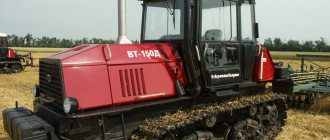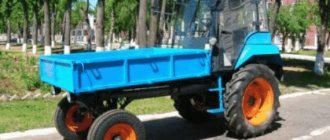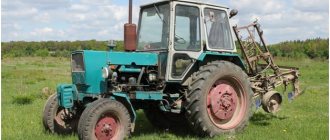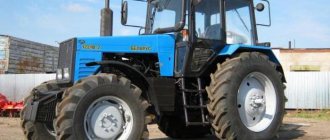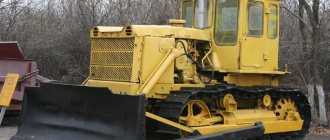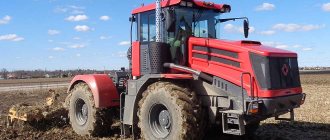Engine
| Model | YaMZ 236NE2-51 | |
| engine's type | diesel with turbocharging, with charge air cooling | |
| Rated power, kW (hp) | 132(180) | |
| Number and arrangement of cylinders % | 6-cylinder, V-shaped | |
| Nominal rotation speed, rpm | 1500 | |
| Maximum torque, Nm (kgfm) | 1160 (118,4) | |
| Specific fuel consumption, g/kW h (g/hp h) | 223 (164) | |
| Cylinder diameter, mm | ||
| Piston stroke, mm | ||
| Cooling system | ||
| Air purifier | ||
| Lubrication system | ||
| Starting system | ||
Specifications
The car is built according to a traditional layout with a front-mounted power unit. The machine is based on a frame consisting of 2 spars. They are reinforced with steel profiles welded along the entire length.
The T-100 caterpillar tractor was not inferior in technical characteristics to similar foreign-made equipment. The weight of the car was considered a disadvantage. A fully equipped T-100M weighed 11.1 tons, which reduced the vehicle's maneuverability on loose soil and swamps.
Engine
The machine uses a 4-cylinder naturally aspirated diesel engine D-108 with a power of 108 hp. With. at 1070 rpm. The engine is equipped with a forced liquid cooling system. The combustion chamber is made in the form of a spherical recess in the piston, which improves efficiency and increases the traction parameters of the engine. The cylinder block is equipped with replaceable cast iron liners. The diesel engine has 2 cylinder heads. The gas distribution mechanism has a lower shaft position and valve drive by rods and rocker arms.
The power unit is started using a separate 2-cylinder 17-horsepower gasoline engine. The starter is started manually or using an electric motor. The battery is installed inside the cabin. Manual starting is carried out using a special device included in the delivery package of the tractor. The starter cooling jacket is combined with the diesel jacket, which allows the liquid to be warmed up.
A gasoline pre-heater was installed as a separate order. The device provided heating of the air supplied to the diesel cylinders.
Fuel consumption
Fuel efficiency was an advantage of the new car. Fuel consumption at operating speed was 19 kg/h. At idle, the tractor consumed 2-2.5 kg of fuel per hour. To reduce fuel consumption on diesel engines, a system is used to cut off the fuel supply to 2 cylinders. The device only worked at idle and cut off the supply to cylinders 2 and 3.
The fuel supply is located in a single tank with a volume of 235 liters. For accelerated refueling, a vacuum pump powered by exhaust gases was used.
Transmission and drive mechanism
To transmit torque to transmission units, a clutch equipped with 1 dry friction disc is used. The clutch design has a cast iron drive disc, to which 2 drive discs with friction linings are pressed. The drive disk is connected to the flywheel by flexible connections, which are rubber-cord linings.
The car used a manual gearbox, providing 5 forward gears. The box is equipped with a reverse mechanism, allowing you to use 4 speeds for reversing. There is a fuse in the box that does not allow the gear to be changed when the clutch is closed. The gearbox housing is rigidly mounted on the rear axle housing.
The transmission provides a maximum forward speed of 2.3-10.1 km/h.
The bridge housing is divided into 3 sections. The main gear is installed in the middle part, and multi-disc steering clutches, complemented by band brake mechanisms, are located on the sides. The bevel main pair is equipped with helical gears. Rotation is transmitted to the drive wheels through a 2-stage gearbox equipped with spur gears.
The tracked bogies of the left and right sides differ in the design of the guide frame. There are 5 road wheels installed on a welded frame. The upper branch of the caterpillar is supported by 2 rollers. At the front there is a cast guide wheel. It can be moved by guides, adjusting the tension of the track. The 500 mm wide track is equipped with bolted steel shoes. The track is closed using a special bushing and pin, which allows the belt to be disassembled for repair.
Suspension and handling
The tractor uses a semi-rigid suspension. The carts located on the sides of the machine are connected to the frame at hinge joints. The front part of the tractor rests on bogies through a leaf spring. The latter is mounted movably on a balancer placed in a special box on the side members of the tractor frame. There is a cover on the bottom of the box that secures the balancer. The cover mounting points are used to secure a pair of additional springs.
The clutch is controlled by a pedal connected to a cam mechanism. Forward gear shifting is performed using a rocker lever. A separate lever is used to engage reverse speeds. To turn, 2 levers are used that act on the side clutches. The drive uses a hydraulic booster, which reduces the load on the operator. The amplifier is powered by a separate oil pump mounted on a diesel engine. On the later version of the 100M3, a single control lever began to be used.
Braking is performed with 2 pedals. Additionally, a mountain brake is installed, which fixes the belts in a partially tightened state. The mountain brake is controlled using special clamps. On the later version of the 100M3, the exhaust brake is controlled by a separate pedal.
Cabin
The tractor cabin has a completely metal structure. The windshield frame is installed at an angle. The operator's seat is equipped with soft cushions and cabin lighting is installed. The machine uses a ventilation system operating from the engine impeller. Part of the air needed to cool the radiator is taken from the cabin through an adjustable valve.
The standard heating system is built on the principle of pumping warm air passed through a radiator. Because of this, the tractor cabin is noisy, exhaust gases and oil and fuel vapors penetrate inside. The heating efficiency is insufficient; at low temperatures, the glass becomes covered with frost.
Transmission
Mechanical.
Remote pumping axis for bogies - increased transmission life
Maximum towing forces and idle speeds of the base model
| speed, km/h | traction force, kN | speed, km/h | |
| I | 3,61 | 151 | 4,48 |
| II | 6,40 | 142 | 7,94 |
| III | 10,09 | 83 | 12,51 |
Mechanical transmission (index “1”)
| Clutch | permanently closed, dry friction, hydroserved |
| Transmission | four-shaft with constant mesh gears, provides eight speeds forward and four in reverse. Available in versions adapted and not adapted for the installation of a power take-off shaft and a creeper. Transforms into a six-speed by locking the first gear of the normal and accelerated ranges (for some complete sets of swamp modification tractors) |
The main gear, final clutches, brakes and final drives are the same as those of a hydromechanical transmission.
Maximum traction forces and travel speeds for tractors with a mechanical transmission and a 180 hp engine. (at rated crankshaft speed)
| normal range | acceleration range | speed, km/h | |||
| speed, km/h | traction force, kN | speed, km/h | traction force, kN | ||
| I | 2,58 | 142 | 3,07 | 122 | 3,01 |
| II | 3,57 | 103 | 4,25 | 85 | 4,18 |
| III | 5,20 | 67 | 6,20 | 54 | 6,06 |
| IV | 8,70 | 35 | 10,40 | 27 | 10,20 |
T 10 tractor technical specifications. Tractors T-10 and B-10
Heavy tracked vehicles are always welcome in the industrial and utility sectors.
With the help of such tractors, you can perform any task, simplify it and reduce the amount of time spent on work several times. The T 10 tractor is a popular unit that began to be produced on the Russian market in 2003. This model is still considered the best example of engineering design, as it has increased dimensions, better cross-country ability and maneuverability. This largest tractor in the world remains one of the most sought after.
The unit can be used to perform a variety of jobs under the heaviest load. The T 10 tractor received more than 80 modifications, among which the T 10 bulldozer and the T-10 M unit stand out.
You can see how the tractor works
Bulldozer B 10 technical characteristics
The model is an improved T 10 tractor, developed at the Chelyabinsk Tractor Plant. Its special feature is the presence of a bucket, thanks to which you can dig pits.
The B 10 tractor is necessary for cultivating various types of soil, as well as frozen areas or soils with stones and rocks. It is able to withstand maximum loads, is unpretentious and remains operational at temperatures from +40 to -50 degrees. The bulldozer copes well with work in wet or excessively dusty areas.
Bulldozer B 10 belongs to the tenth traction class and has a hydromechanical transmission. A winch installation can be attached to it, with the help of which you can harvest or transport timber, or eliminate the consequences of accidents or natural disasters. Good cross-country ability and high maneuverability of the bulldozer allow it to be used in various jobs.
Main characteristics of the bulldozer:
- The engine power is 190 hp. With;
- fuel consumption 162 g/kW per hour;
- fuel tank volume 320 l;
- can accelerate to 10.38 km/h;
- dimensions: 4290x3180x2480 mm;
- weight – 15330 kg;
- ground clearance is 435 mm;
- The track is 1880 mm.
The bulldozer is equipped with a comfortable cabin with a heating device, thanks to which working on it will be as convenient as possible.
Tractor T 10 technical specifications
The model is used for industrial purposes, can operate in a variety of climatic conditions and has an improved design. The T 10 tracked mini tractor performs a wide variety of work, including loading and unloading, and is used for construction and site cultivation.
Specifications:
- The engine power is 170 hp. With;
- manual transmission;
- rigid towbar;
- three-speed gearbox;
- fuel consumption is 218 g/kW per hour;
- weight is 15000 kg;
- Dimensions are 4600x2480x3180 mm.
All tractor spare parts are freely available, so you can repair it yourself.
The T 10 unit is no longer produced, but remains one of the most popular. Thanks to the reinforced chassis and the ability to add attachments, the tractor is well suited for any work.
Chassis system
| Number of road wheels on each side | 6 7 |
| Number of support rollers on each side | 2 1 |
| Tension mechanism | hydraulic |
| Track shoe width, mm | 500 690 900 (swamp) 460 (lightweight) |
| Pitch, mm | 203 |
| Grouser height, mm | 65 |
| Specific ground pressure, MPa | 0,076 |
Tractor performance characteristics
The technical characteristics of the 10th traction class tractor at the time of its creation were outstanding. It is for this reason that it continued to be produced with minimal changes for more than 10 years in a row. It is worth mentioning a number of features of this technique. There are both pros and cons. They are connected precisely with the technical characteristics of the caterpillar tractor.
Dimensional and mass indicators
The overall dimensions of the tractor were large, but they made it possible to easily use the equipment to solve the most complex problems, even in conditions of lack of free space. The overall dimensions of the standard model of the T-100 tractor without any modifications are as follows :
- length - 4.2 m;
- width - 2.4 m;
- height - 3 m;
- track - 1.8 m.
The length of the supporting surface of the tracks is 2.3 m. It is due to this that the high cross-country ability of this type of equipment is achieved. The T-100 tractor easily overcomes difficult sections of the road and swampy areas. You can verify this either yourself or by watching a video of the operation of this equipment in difficult road conditions.
The ground clearance is 331 mm. Large ground clearance allows you to easily overcome various types of ruts and other difficult sections of roads - where the decisive factor is the distance from the bottom of the chassis to the road. The specific pressure on the soil is 0.47 kgf/cm2. Therefore, the tractor does not fail on difficult, problematic soil. Metal consumption, kg/hp - 102.
A distinctive feature for its time is the high draft force - 6000 kg. Moreover, the tractor itself, in its design position, weighed only 11 tons. Which was relatively little for equipment of this type with such technical parameters, considering the year of development and production. The maximum traction force in first gear is 9.5 tons.
At the same time, as the speed increases, the draft force decreases significantly. In the very last fifth gear it is only 5 tons. Therefore, when driving with a load or a trailer, it will be necessary to use a lower gear. This greatly simplifies movement, especially in difficult road conditions.
Engine
Initially, the basic modification is equipped with a D-108 engine. This motor was developed specifically for the T-100 tracked tractor. That is why its use is most effective. This engine is a four-cylinder engine, its distinctive feature is an inseparable KVZ.
It itself is located in the engine pistons. The standard power of such a tractor is 108 hp. Which was considered quite an outstanding indicator for the middle of the last century. This figure is achieved only at a crankshaft rotation speed of 1070 rpm.
The engine displacement is 150 cm3. The piston diameter is 0.145 m. The weight of the motor was exactly 2.1 tons - almost ½ of the total curb weight of the tractor itself. If it is necessary to work in difficult conditions, some power reserve will significantly help. To start at subzero temperatures, a P-23 launcher with a special starter is used. The volume of the fuel tank is two hundred thirty-five liters.
Distinctive features of this unit model are:
- the nozzles have not 1 atomizer installed, but as many as 9 pieces;
- A jet-type centrifuge is installed in the oil purification filter.
It is due to the reduced compression value that it became possible to simplify the start of the power unit. The maximum torque is set at 82 kgm.
Transmission
The “weaving” transmission does not differ much from its predecessor. The design includes a coupling coupling. Its main advantage is the ability to easily dismantle it if necessary.
Since it actually represents an independent node. A manual gearbox was used:
- five speeds - for moving forward;
- four speeds - for moving backwards.
Box type - reversible, three-way. A conical type is used as a central gear. For turning, a special multi-disc dry clutch was used. The driven discs were equipped with friction linings. They were controlled using specialized servo levers. The running mechanism itself is of a semi-rigid type, it consists of tracked bogies. A balancing device has been installed.
Cabin of the T-100 tractor: overview of the workplace
The cabin of the T-100 tractor in all modifications was necessarily mounted on a rigid frame. Moreover, only the shape was different from the previous model under the designation S-100. Otherwise, the T-100 did not undergo any significant changes. Today, working in such a cabin is quite inconvenient compared to similar modern tractor models. But for its time, the interior of the tractor was quite comfortable.
There was lighting, as well as a soft seat for the driver himself. There was a heater and a forced ventilation system. But this was precisely the reason for the increased noise directly inside the cabin.
Electrical equipment
| Rated voltage, V | 24 |
| Alternating current generator 966.3701, power, kW | 1 with rectifier and electronic voltage regulator |
| Rechargeable batteries 6ST-182EMS, pcs. | 2 |
| Starter 251.3708, power, kW | 8,2 |
Cabin
Frame, installed on a vibration-isolated platform, has a modern design. A large glass area, convenient location of controls, a sprung seat adjustable according to the weight and height of the operator, a hot-air heater, sun blinds, etc. provide increased comfort when working. The instrument panel, manufactured in a non-hazardous design, is equipped with indicators and alarms that allow the operator to control the operation of all major tractor systems. The cab's protective frame (ROPS-FOPS) protects the operator during rollovers and from falling objects. Upon customer request, it can be equipped with air conditioning (features).
Operating experience of the T-100 tractor: advantages and disadvantages
This type of tractor has not been produced for quite some time. Therefore, purchasing new spare parts is quite problematic. At the same time, it is not difficult to buy an already unused T-100 relatively inexpensively and gradually install entire parts on the operating “weaving”.
The main advantages of the tractor include:
the ability to easily install additional attachments:
- soil loosener, stump removal;
- equipment for work in agriculture, reclamation;
- pile driver for installation of piles, as well as a crane;
For aggregation it is possible to use more than 14 types of different equipment:
- relative ease of repair of this equipment;
- unpretentiousness to fuel, as well as other refueling containers.
The most important disadvantage is the lack of any comfort at work.
Also, do not forget that with an increase in the speed of the tractor, the draft force decreased significantly - from 6 tons to 2 tons. This point must be taken into account when working on difficult soils, in the presence of attachments and a trailer.
Bulldozer with a fixed blade based on the T-100MGS tractor in operation
Another important advantage is the existence of a large number of different modifications. Due to this, it is possible to easily solve a wide range of different tasks. It is the swamp rover that deserves special attention. It is on the territory of the Chelyabinsk region that there are a large number of formations of this type. What made the T-100B simply irreplaceable.
Hydraulic system
Separate hydraulic system with gear type pump. Hydraulic system configuration depending on the installed attachments. The main hydraulic pump of the gear type NSh-100 is installed on the engine and is driven by its distribution gears. A full-flow filter with Regotmas filter elements has a cleaning fineness of 25 microns and is installed on the drain route. Hydraulic distributor P160, three-spool, three-position.
| Nominal pressure in the system, MPa | 16 |
| Safety valve setting pressure, MPa | 18 — 20 |
| Hydraulic cylinders of the front linkage system: | |
| — hydraulic cylinder diameter, mm | 100 |
| — diameter and stroke of the rod, mm | 60x800 |
| Blade skewing hydraulic cylinder: | |
| — hydraulic cylinder diameter, mm | 160 |
| — rod stroke, mm | 200 |
| Ripper hydraulic cylinder: | |
| — hydraulic cylinder diameter, mm | 160 |
| — rod stroke, mm | 450 |
Refill tanks, l
| Fuel tank | 300 |
| Cooling system | 60 |
| Engine lubrication system | 32 |
| Gearbox and rear axle - hydromechanical transmission - mechanical transmission | 90 50 |
| Final drive (each) | 12 |
| Hydraulic system | 100 |

